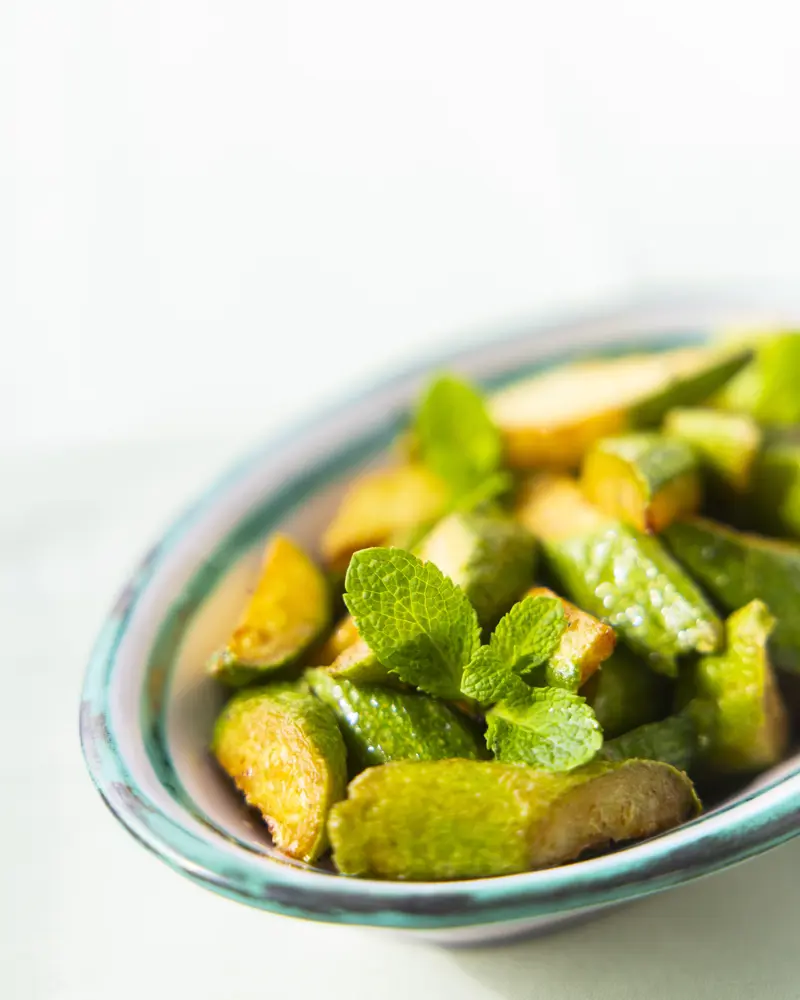ZUCCHINI ALLA SCAPECE
16.06.2025 RECIPES
The answer, as often, is: it depends. With the exception of Tuscany, Piedmont and Sardinia, the standard Italian form is the feminine la zucchina. In Rome, a market shopper who wants a kilo of the succulent gourds would generally say ‘Mi dia un chilo di zucchine, per favore’. However, the Accademia della Crusca – the august authority that presides over correct Italian usage – has decreed that the masculine form (zucchino/zucchini) is to be preferred. So our advice is to choose one, and stick to it. And let’s not even start on the English-language dilemmas. Courgettes or zucchini? Eggplants or aubergines? Life’s too short…
The cooking method known in and around Naples as ‘alla scapece’ simply means marinading fried vegetables in vinegar. Testimony to the city’s long connection with the royal courts and culture of the Bourbons, the name derives from the Spanish term escabeche, which in turn is adapted from an Arabic word for a food preservation technique that is even cited in the ancient folktale collection One Thousand and One Nights. Back in the days when fridges and freezers didn’t exist, conservation in vinegar allowed home cooks to make food in batches safe in the knowledge that it would keep for several days.
Meat and fish can be done scapece style, as well as vegetables. But in Naples it was above all this zucchini dish that survived the transition to refrigerated food preservation and became a staple of the local culinary repertoire. It’s not difficult to see why: the contrast between the sharp tang of vinegar and the sweet mildness of the zucchini, offset by the fresh spearmint garnish, is highly pleasing, and more than a little addictive.
Le Sirenuse’s executive chef, Girolamo Russo, believes that the simpler the dish, the more important it is to cut no corners. He suggests avoiding large green zucchini that are full of water and have little taste. The variety Gennaro recommends are those small mid- to light-green ones with ridged sides that are typically sold with the yellow flower still attached. In Italy these are generally referred to as romaneschi or romanesche. The olive oil needs to be not just extra-virgin but good extra-virgin, and the vinegar should ideally be a reputable brand of Spanish sherry vinegar.
ZUCCHINI ‘SCAPECE’ STYLE
serves 4
1kg (2.2lb) tender young zucchini (romaneschi or similar)
500ml (around 2 cups) peanut oil for frying
100ml (3½ fl.oz) sherry vinegar for marinade
30ml (1 fl.oz) extra-virgin olive oil for marinade
A generous bunch of spearmint (Mentha spicata)
One garlic clove, crushed

Some scapece fans like to cut the zucchini into thin rounds, but for Gennaro this makes them absorb too much oil and vinegar and become soggy. He likes to slice them in half lengthways then make diagonal cuts to create lozenge-shaped chunks around 3 or 4 centimetres long.
You are welcome to use olive oil for the frying – most Neapolitan home cooks would. But Gennaro prefers to use this just for the marinade. For the frying he suggests using peanut oil, an equally healthy alternative, as it gives a lighter result. Heat the peanut oil until it reaches 180°C (360°F), add the zucchini pieces, fry until light golden brown (this should take a couple of minutes), remove and shake well or place on kitchen paper to drain off as much oil as possible.
Pour the sherry vinegar and olive oil into the bowl you plan to serve the dish in, mix well, add the zucchini chunks and crushed garlic clove, sprinkle mint leaves over (whole or chopped, your call) and toss well. Leave to marinate for at least an hour. You may want to remove the garlic clove before serving.
Photos © Roberto Salomone
Le Sirenuse Newsletter
Stay up to date
Sign up to our newsletter for regular updates on Amalfi Coast stories, events, recipes and glorious sunsets



